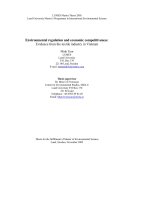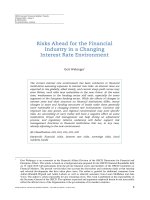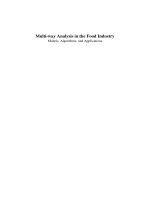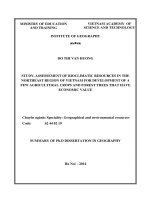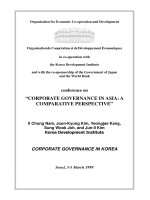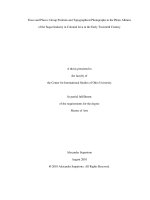The automobile industry in Vietnam and Thailand in a comparative perspective
Bạn đang xem bản rút gọn của tài liệu. Xem và tải ngay bản đầy đủ của tài liệu tại đây (758.98 KB, 48 trang )
MINISTRY OF EDUCATION AND TRAINING
UNIVERSITY OF ECONOMICS HOCHIMINH CITY
FULBRIGHT ECONOMICS TEACHING PROGRAMME
HUNH TH KIU OANH
THE AUTOMOBILE INDUSTRY IN VIETNAM AND
THAILAND IN A COMPARATIVE PERSPECTIVE
MASTER’S THESIS ON ECONOMICS
MAJOR: PUBLIC POLICY
CODE: 603114
Supervisor: Jonathan R. Pincus
HOCHIMINH CITY, 2010
i
CERTIFICATION
I certify that the substance of the study has not already been submitted for any degree
and is not being currently submitted for any other degrees.
I certify that to the best of my knowledge any help received in preparing the study
and all sources used have been acknowledged in the study.
The study does not necessarily reflect the views of the Ho Chi Minh City Economics
University or Fulbright Economics Teaching Program.
Huynh Thi Kieu Oanh
ii
ACRONYMS AND ABBREVIATIONS
AFTA ASEAN Free Trade Agreement
AICO ASEAN Industrial Cooperation Organization
BBC Brand-to-Brand Complementation
CEFT Common Effective Preferential Tariff
CBU Completely Built Unit
CKD Completely Knocked Down
IEs Industrial Estates
IL Inclusion List
IKD Incompletely Knocked Down
JVs Joint ventures
LVCs light commercial vehicles
Samco Saigon auto-mechanics Corporation
TEL Temporary Exclusion List
UK United Kingdom
US United States
VEAM Vietnam Engine & Agriculture Machinery
Corporation
Vinacoal Vietnam Coal Corporation
Vinamotor Vietnam Motor Corporation
WTO World Trade Organization
iii
ACKOWLEDGMENTS
To finish this paper, I have received many helps.
I am heartily grateful to Professor Jonathan R. Pincus for his supervision and
guidance. His support and guidance from the initial to the final level help me to
develop this subject. He also read and corrected my grammars very carefully and in
details.
Also I would like to thank FULBRIGHT teachers and staffs in helping me to broaden
my view and knowledge during my studying.
And I would like to express my deepest gratitude to my parents and friends in
supporting me.
I offer my regards and blessings to all of those who supported me in any respect
during the completion of the paper.
Huynh Thi Kieu Oanh
iv
CONTENTS
1. INTRODUCTION 1
2. THE AUTOMOBILE INDUSTRY 4
2.1. Performance 5
2.1.1. Thailand 5
2.1.2. Vietnam 9
2.2. Policies and development 13
2.2.1. Thailand 13
Before the 1997 crisis: protectism, agglomeration and development 13
Tariff and tax policy 14
Localization and other policies 15
Developments of the automobile cluster and supporting industries 18
After the 1997 crisis: Trade and investment liberalization and global and
regional integration 19
Abolishing local content requirements and restructuring tariffs and other
taxes 19
Promoting the development of related and supporting industries and large
automobile cluster investments 21
2.2.2. Vietnam 22
Before 2004: High protection for agglomeration 23
After 2004: Protection decreasing, but remains high 25
2.3. Explaining the differences and learning 27
2.3.1. Differences 27
2.3.2. Explanation 28
The domestic market is shrunk by government’s policies, especially
current tariff and taxes 28
Supporting industries in Vietnam have not developed, especially an
autoparts industry to be able to localize production 31
v
Vietnam also has some policies, such as land, R&D, financing policies but they
are not clear and useful 33
2.3.3. Lessons 33
3. POLICY RECOMMENDATIONS 34
3.1. Changing the current tariff and tax policy 35
3.2. Developing of related and supporting industries 36
3.3. Development of infrastructure 37
4. CONCLUSION 38
REFERENCES 39
APPENDIX 1 42
TABLES
Table 1. List of FDI automakers in Vietnam 10
Table 2. The production volume of 11 JVs (in units), 1996 – 2002 11
Table 3. Tariff and tax rate (%) related to CBU and CKD vehicles, before 1992 –
present 14
Table 4. Regulations to Thailand’ zone 21
FIGURES
Figure 1. Major functions within the automobile industry 1
Figure 2. Competitiveness Diamond 4
Figure 3. Thailand’s automobile production (in units), 1993 – 2008 6
Figure 4. Thailand’s automobile sales (in units), 1993 – 2008 7
Figure 5. Thailand’s automobile sales share by producers (%), 2005 7
Figure 6. Thailand’s automobile exports (in units), 1996 – 2008 8
Figure 7. The VAMA’s sales volume (in units), 2000 – 2009 11
Figure 8. Vietnam’s automobile sales share by companies (%), 2005 12
1
1. INTRODUCTION
The automobile industry was acknowledged as the “the industry of industries” in
the twentieth century and is considered one of the most globalised industries today
(Wad, 2009). From Figure 1, we see that the automobile industry is related closely
to many industries such as steel, electronics and textiles and contributes to the
development of many service industries such as finance, marketing, retailing and
banking. So a country that has a developed automobile industry will create good
conditions for promoting the development of other industries. This industry
contributes largely to socio - economic development and job creation. So, in the
ASEAN countries, such as the Philippines, Thailand, Indonesia, Vietnam and
Malaysia, it is one of the most important and supported industries. Development of
the automobile industry, covering car and component manufacturing, is usually
sought by policymakers in the developing and developed countries (Kohpaiboon,
2008).
Figure 1. Major functions within the automobile industry
BODIES
MAJOR
SUPPLYING
INDUSTRIES
Manufacture and
Stamping of body panels
Body assembly
and painting
Source: The changing nature of the Asian automobile industries (cited from
/> )
Steel and other
metals
Rubber
Electronics
Plastic
Glass
Textiles
COMPONENTS
a. Manufacture of mechanical and electrical
components, e.g. instruments, braking system,
steering components
b. Manufature of wheels, types, seats, windscreens,
exhaust systems, etc
Final
assembly
CONSUMER
MARKET
ENGINES AND TRANSMISSIONS
Forging and casing of
engine and transmission
Machining and assembly of
engines and transmissions
2
Vietnam’ automobile industry has begun since 1991. But up to now, it is small and
underdeveloped. Sales volume is very low, about 100,000 units per year. This
influences very much to generate economies of scale of assemblers and autoparts
companies. And now the local assembly industry in Vietnam is dominated by
foreign-invested joint ventures (JVs). It is focused solely on serving the domestic
market. In recent years, Vietnam has had many incentives to protect its automobile
industry with a view to increasing the local content and reducing the price of
vehicles. However, up to now, the local content rate is only about between 2% to
10%. So, local assembly products are heavily reliant on imported parts. In addition,
car price is very high. According to the survey of the Ministry of Finance, on
November 8
th
, 2008 the Toyota Corolla 1.8MT was sold in Vietnam with the price
of 19,532 USD while in other countries, it was sold 15,350 USD. Similarly, the
Toyota Camry 3.5 is 38,510 USD in Vietnam while the world price is from 24,215
USD and 28,695 USD. These results are against the government’s expectation and
also demonstrate that Vietnam’s policies have not worked in the automobile
industry.
As mentioned above, the automobile industry is supported and encouraged by many
countries in the ASEAN. The automobile industry in these countries generated
some achievements, especially Thailand. Now Thailand’s automotive industry is a
key sector in the overall economy that account for 11.3% of GDP in manufacturing
and employed 1.2 million workers in 2008 (Sirisuwanangkura, 2009). The local
content rate is between 60% and 80% depending on the type of vehicles. Since
2005, Thailand has become the largest production hub of ASEAN and rank number
14 in global production in 2008. To achieve these results, the government’s policies
contributed a large part.
The study chose Thailand as a comparative object because Thailand and Vietnam
are in the ASEAN region. In the past, present and future, the WTO and regional
commitments influence much to the automobile industries in Vietnam and Thailand.
3
Additionally, Thailand is an example of success in the development of the
automobile industry in the ASEAN.
As known, these results in the automobile depend in large part on government
policies. Thailand has been successful in building industrial policies such as tariff
and tax policies, local content requirements, supporting industrial development and
cluster – based automobile industry development, while Vietnam’s policies have not
promoted the domestic automobile industry.
This study does not focus on finding out these results in two countries. It
demonstrates the ways in which the policies have resulted in differences. So, the
study focuses on answering these following questions:
1. Which policies influenced the development of the automobile industry in Thailand
in the last years?
2. Which policies used to support the development of the automobile industry in
Vietnam?
3. Why are not Vietnam’s policies effective to the automobile industry in
comparison with the effect of Thailand’s policies?
About methodology and collecting data: Almost data of the study is secondary data.
It is collected from various sources, such as the reports of Vietnam’s Ministry of
Industry, the VAMA, the websites of automobile companies in Vietnam, the
available data of the TAIA from its website, the articles about Vietnam automobile
market information at Vietnam automobile Magazine and other sources.
About thesis restrictions: To write this paper, I put myself in the position of a policy
maker. And policy commendations only focus on the side of state and are to repair
the government failures.
4
This paper is organized as follows. The next section analyses the Vietnamese and
Thailand’s automobile industries and explains the differences described above.
Section 3 gives policy recommendations. The final section concludes and
summarizes.
2.
THE AUTOMOBILE INDUSTRY
Using the diamond model of Michael Porter, there are four decisive factors in the
competitiveness of the industry as shown in Figure 2 (Porter, 1998). It includes firm
strategy, structure and rivalry, factor conditions, demand conditions and, related and
supporting industries.
The role of government policies in this model is to affect the other four factors with
a view to moving to higher levels of competitive performance. These main policies
include tariff and tax policy, localization, cluster-based development policy and
supporting industry development.
Figure 2: Competitiveness Diamond
Government
policies
Firm strategy,
structure and
rivalry
Demand
conditions
Source: Porter, 1998
Factor
conditions
Related and
supporting
industries
5
Over time, impact of these policies has contributed to differences between Vietnam
and Thailand. Based on this model, the study demonstrates the effect of the policies
through impact of the government’s policies to the other four factors.
2.1. Performance
It is difficult and complicated to compare to the auto industry in two countries
because of the differences in starting points and domestic conditions. The purpose
of this study is to demonstrate the ways in which the policies have resulted in
differences.
2.1.1. Thailand
Thailand launched its automobile industry in the 1960s. Based on government
policies, the country has developed a global and regional automobile industry. Over
40 years, this industry has grown from an import – substitution to an export –
oriented industry.
The Thai automobile industry supplier network is built as a pyramid, with 15 car
assemblers (see Appendix I), 648 tier – 1 suppliers and 1.641 tier – 2 suppliers
(Sirisuwanangkura, 2009). About 80% of the country’s overall automobile
assembling capacity belongs to Japanese companies. Most of these Original
Equipment Manufacturers (OEMs) are mainly members of Japanese keiretsu groups
supplying their own customer bases. The companies can be categorized into three
groups: members of a Japanese family of companies; joint ventures with Japanese
technology owners; and, companies that have technical assistance or licensing
agreements with Japanese firms (Royal Danish Embassy, 2006). Together with
Japanese firms, many new investments by non-Japanese tier-1 suppliers have
entered the country. Most Thai owned companies are in tier 2 or 3.
Figure 3 shows that the production of vehicles has picked up strongly after the post
– 1997 crisis. During the crisis, production fell rapidly, from 555,821 in 1996 to
6
143,250 in 1998. However, in 2005, production volume exceeded one millions units
and Thailand is the largest production hub of automobiles in ASEAN. In 2008, the
total production of vehicles was 1,391,728 units, compared with only 143,250
vehicles in 1998. About the structure of products in 2008, Thailand mainly
produced one-ton trucks and pick-up trucks. This matches domestic demand as
shown in Figure 4.
Figure 3. Thailand’s automobile production (in units), 1993 - 2008
Source: The Thailand Automobile Industry Association (retrieved data from
/>, 10/2009)
Sales can be classified into two types: passenger cars and commercial vehicles. In
Thailand, domestic demand is weighted towards light commercial vehicles,
especially one-ton vans and pick-up trucks. Commercial vehicles in total accounted
for around two – thirds of domestic demand. The tax regime has favored the
purchase of these vehicles rather than passenger cars. In 2008, 238,990 passenger
cars were sold, up by 30% from 182,767 units in 2007. More than 95% of local auto
demand was met by domestic production. Locally assembled one – ton pickups
7
account for about two-third of the total sector in Thailand. This makes Thailand the
second largest market for pickup trucks in the world, after the US.
Figure 4. Thailand’s automobile sales (in units), 1993 – 2008
Source: The Thailand Automobile Industry Association (retrieved data from
/>, 10/2009)
Figure 5. Thailand’s automobile sales share by producers (%), in 2005
Source: The Thailand Automobile Industry Association, 2005
8
As shown in Figure 5, vehicle sales were dominated by two brands: Toyota and
Isuzu. Toyota has the largest market share, with 39.8% in 2005. Isuzu has greatly
increased its market share and accounted for 25.4%. Honda, Mitsubishi and Nissan
follow with market shares of 7.7%, 6.8% and 5.9%, respectively. United States
automobile companies have also increased their presence in the market. Japanese
manufacturers controlled nearly 90% of the market.
After meeting domestic demand, the automobile companies export vehicles.
Thailand has become more export oriented since 1996. Exports have increased
gradually from 1999. In 2008, a total of 775,652 units were exported with a value of
516,244 million THB. Major car export markets were Australia, Indonesia and the
UK while vehicle components and parts were exported to Japan, the US and
Malaysia.
Figure 6. Thailand’s automobile export (in units), 1996 - 2008
Source: The Thailand Automobile Industry Association (retrieved data from
/>, 10/2009)
9
2.1.2. Vietnam
Before 1991, cars in Vietnam were mainly imported from the socialist countries.
Domestic companies had not invested in auto assembling, and were only focused on
repairing imported vehicles.
Since 1991 the automobile industry has begun to change dramatically as Vietnam
opened its economy to international trade and investment. In 1991, the first joint-
venture with the Philippines was formed in Vietnam, a company called Vietnam
Motors Corporation (VMC).
At present, Vietnam has 12 automobile joint-ventures (see Table 1), more than 40
foreign autopart companies and 100 domestic companies, including 20 Completely
Knocked Down (CKD) kits assemblers and repairers, 20 body-trailer-barrel builders
and 60 parts manufacturers. Joint-ventures (JVs) consist of seven Japanese
automakers (Daihatsu, Hino, Isuzu, Mitsubishi, Suzuki, Toyota and Honda), one
Korean automaker (Daewoo), one Korean-backed licensed assembler (Mekong),
one Philippine-backed licensed assembler (VMC), one German automaker
(Mercedes), and one American automaker (Ford). JVs are capable of manufacturing
any kind of vehicle demanded by the domestic market, but Hino Motors specializes
in heavy trucks.
Most of the JVs were established before 1996. They play an important role in the
Vietnam’s automobile industry. The total registered investment capital of JVs is
574.7 million USD and total real investment capital to the year 2002 was 419.85
millions USD (74% of registered capital). In 2005, Honda invested in producing
cars. As of 2005, total real investment capital was about 536 million USD.
By 2002, the total registered capacity of eleven JVs was 148,200 units per year.
However, these JVs used just 30% of total registered capacity and focused on
assembling. Before 2004, the activities of eleven JVs dominated the Vietnamese
10
automobile industry. The production volume of the eleven JVs accounted for more
than 90% of the domestic market. Products were diversified in many models. They
produced mainly cars to satisfy domestic market demand. Only Hino Motors
Company specialized in heavy duty trucks.
Table 1. List of FDI automakers in Vietnam
S
T
T
Company
Home
Country
Company
Type
Start
Date
Location
Registered
capital
(million $)
Capacity
(units/year)
1
MEKONG
CORPORATION
Korea
License
Assembler
1992 HCMC 60 5,000
2
VIETNAM MOTOR
CORP.
Philippine
License
Assembler
1992 Hanoi 35 20,000
3 VIDAMCO Korea Automaker 1993 Hanoi 32 10,500
4 VINASTAR Japan Automaker 1994 HCMC 50 5,000
5 MERCEDES BENZ VN Germany Automaker 1995 HCMC 70 10,000
6 VISUCO Japan Automaker 1995 HCMC 21 12,400
7 VINDACO Japan Automaker 1995 HCMC 10 3,600
8 FORD VIETNAM US Automaker 1995 Hanoi 102 14,000
9 TOYOTA VIETNAM Japan Automaker 1995 Hanoi 89 20,000
10 ISUZU VIETNAM Japan Automaker 1995 HCMC 50 10,000
11 HINO VIETNAM Japan Automaker 1996 Hanoi 17 1,760
12 HONDA VIETNAM Japan Automaker 2005 Hanoi 70 20,000
Source: Compiled from websites of automobile companies
Table 2 shows the production volume of 11 JVs from 1996 to 2002. We see that in
this period, the eleven JVs had assembled a total of 84,585 vehicles, achieved USD
1,976.6 million in sales and earned profits of USD 24.4 million. The production
volume of vehicles remains low, but is increasing annually. In 1996, total
production volume was only 5,538 vehicles. However in 2000, automobile
companies produced 13,955 units, up by 155%. Production volume in 2002 was
about 26,706 vehicles, a two fold increase over 2000.
11
Table 2. The production volume of 11 JVs (in units), 1996 - 2002
Company 1996 1997 1998 1999 2000 2001 2002
TOYOTA 201 1.277 1.836 2.179 4.600 5.759 7.335
VIDAMCO 1.014 689 465 1.097 1.750 2.906 3.719
FORD VIETNAM 11 362 325 1.195 1.915 3.685
MERCEDES BENZ VN 71 359 252 183 547 1.874 2.622
VIETNAM MOTOR CORP. 2.090 1.341 950 1.250 2.222 1.800 2.358
VINASTAR 482 622 702 650 858 1.612 2.440
VISUCO 161 489 386 320 948 1.508 2.122
MEKONG CORPORATION 964 527 417 281 414 866 907
ISUZU VIETNAM 57 148 200 483 744 870
VINDACO 555 556 345 434 779 469 492
HINO VIETNAM 12 64 44 81 103 156
Total 5.538 5.940 5.927 6.963 13.955 19.556 26.706
Source: Compiled from report of the Ministry of Industry in order to use for the
Master Plan for Developing Vietnam’s Automobile Industry, 10/2004
Figure 7. The VAMA’s sales volume (in units), 2000 – 2009
13239
18960
26635
42557
40138 40277
40897
80392
110184 110000
0
20000
40000
60000
80000
100000
120000
2000 2001 2002 2003 2004 2005 2006 2007 2008 2009(e)
Source: The Vietnam Automobile Manufacturers’ Association, 12/2009
12
VAMA is a non-profit organization founded in 2000, started with 11 JVs and today
has 17 members. The sales volume of VAMA represents that of Vietnam’s auto
market. Figure 7 shows that sales have risen rapidly since 2007, but are still low,
only about 100,000 units per year. Compared with sales of 13,239 units in 2000,
volume has increased to 110,184 vehicles in 2008, nearly ninth times.
In 2005, Toyota Vietnam sold nearly 12,000 units, up 29% year on year and
accounting for 33.3% of VAMA’s overall sales. Following Toyota is Ford, Vinastar
and Vidamco with 14.3%, 11.9% and 11.9%, respectively. The 12 JVs used only
3.7% of capacity in 1996, rising to 13.2%, 18% and 28.8% in 2001, 2002 and 2003
respectively. It is very clear that capacity utilization rates in Vietnam’s automobile
industry are extremely low and JVs are counting on an increase in the size of the
domestic market as the country becomes more prosperous (Nguyen Bich Thuy,
2009).
Figure 8. Vietnam’s automobile sales share by companies (%), in 2005
Source: The Vietnamese Automobile Manufactures Association, 12/2005
Domestic Vietnamese automobile and autopart companies were mostly established
in the 1960s. By 2003, Vietnam had more than 160 domestic companies in
13
assembly and manufacture of autoparts. These included four state owned enterprises
supported largely by the government. They are Vietnam Motor Corporation
(Vinamotor), Saigon auto-mechanics Corporation (Samco), Vietnam Engine and
Agriculture Machinery Corporation (VEAM) and Vietnam Coal Corporation
(Vinacoal). Recently, and especially since 2004, many 100% domestic investment
companies, including private and state own enterprises, have been launched. For
example, Truong Hai auto company invested in producing Kia, Hyundai, Daewoo
and Foton with investment capital of USD 330 million, and TMT corporation
invested USD 250 million in manufacturing pickup trucks. A majority of these
companies import production lines and technology from China, and competition
among enterprises is increasing.
2.2. Policies and development
2.2.1. Thailand:
Before the 1997 crisis: protectism, agglomeration and development
The government’s support and promotion of this industry can be traced back to
1961 when the Thai Motor Industry Company, the first automobile assembly plant,
was established. Only a limited number of auto parts were domestically produced.
These included rubber parts, batteries and leaf springs. In 1969, the Ministry of
Industry formed the Automotive Industry Development Committee under a Cabinet
Resolution of August 26
th
, 1969, in order to impose policies and measures with an
aim to develop the local auto industry. Policies and procedures were put in place to
facilitate the process of moving from assembly to production. The objective of
production was import substitution and reducing the trade deficit. Before 2000, the
assembly companies and parts producers in Thailand were protected through five
main policies: high rate of import tariff and taxes; restricted and limited use of
imported auto parts; protected and controlled imports; no new operating plants; and,
investment promotion.
14
Tariff and tax policy:
Table 3. Tariff and Tax rate (%) related to CBU and CKD Vehicles,
before 1992 – present
Before
1992
1992 1999
2000 –
present
Completely built-up (CBU) vehicles
Passenger cars over 2,400 cc
1
Tariff rate 300 68.5 80 80
Excise tax 44-55 41.8 43-50 41-48
Passenger cars under 2,400 cc
Tariff rate 180 42 80 80
Excise tax 44-55 35.75 41.25 38.5
Pick-up truck
Tariff rate 120 60 60 80
Excise tax 9.9 n.a 5.5 3.3
Completely knocked-down (CKD)
vehicles
Passenger cars over 2,400 cc
Tariff rate 112 42 20 33 (30)
4
Excise tax 44-55 41.8 43-50 41-48
Passenger cars under 2,400 cc
Tariff rate 112 42 20 33
Excise tax 44-55 41.8 41.25 38.5
Pick-up truck
Tariff rate 72 20 20 33
Excise tax
2
9.9 3 5.5 3.3-19.8
3
Notes:
1. Before 1992, the classification of passenger vehicle was 2,300 cc engines
2. Excise taxes include municipal taxes
3. Excise taxes for one-ton pick-up trucks was 3.3% whereas for the so called
“pick-up passenger vehicle” is 19.8%
4. Numbers in parentheses are tariffs in 2005
Source: Kohpaiboon, 2008
Thailand used tariffs as a tool to protect the automobile industry. Before 1992, tariff
rates on most vehicles, except CKD kits of pick up trucks, were over 100%.
However, in 1990 the Ministry of Industry called off the limitation on the number of
15
allowed series and the Ministry of Commerce replaced it with tariff measures in
order to continue restricting passenger car imports. Tariff rates for CBU passenger
cars over 2400 cc. were reduced from 300% before 1992 to 68.5%. For CKD kits of
passenger vehicles with 2400 cc and below, tariff rates were decreased to 42% from
112%. So, the tax burden for imported and domestically assembled cars was
reduced. Consequently, it resulted in a car-price decrease, which benefited
consumers.
Table 3 shows that tariffs and other tax policies were used to protect the domestic
passenger car market more than commercial vehicles. The tariffs on passenger car
were 300% before 1992 and 68.5% in 1992. For commercial vehicles, the rates
were 120% and 42%. The excise tax rate applied before 1992 and in 1992 of CBU
passenger car was 44% - 55% and 41.8%, much higher than that of pickup trucks.
Localization and other policies:
The literature recognizes the important role played by local content regulations in
forcing foreign investors to purchase parts locally (Humphrey and Oeter, 2000). The
regulations in terms of local content and policies mentioned above created the
conditions for the agglomeration of firms.
Local content rates required by Thailand’s Ministry of Industry increased gradually
over time and were different among the types of vehicles.
At first, in 1972, the Ministry of Industry announced the required local content for
passenger cars. From January 1st, 1975, it required assemblers to use at least 25%
locally produced contents. The required percentage was raised from 25% to 50%
within five years according to an announcement of the Ministry of Industry in 1978.
After that, it also required that 15% of the parts used for truck and bus assembly
with chassis and engine should be locally produced. A minimum of 20% local
contents was also required for truck and bus assembly with chassis and windshields.
16
In 1979, the Ministry of Industry announced a standard matrix on the percentage of
local contents required for truck and bus assembly. It required manufacturers to
increase their use of local parts by 5% per annum over the next 5 years.
In 1980 the Automotive Development Committee announced regulations for van
and jeep assembly. The passenger-car assembling policy was applied to van
assembly. Likewise, CBU imports of vans and jeeps also fell into the car-assembly
policy, while CKD imports of jeeps and vans, called “chassis with windshield” or
“chassis with engine”, were in compliance with the truck-and-bus policy. Seven
required parts for truck assembling were later announced, namely radiators, exhaust
pipe sets (including mufflers), batteries, leaf springs, tires and inner tubes, safety
glass and brake drums.
Up to 1981, the locally-produced contents were much more expensive than the
imported ones. So, in 1982, the Ministry of Industry raised the local content
limitation to 45% on passenger-car assembly. Apart from the required local content,
the Ministry began to announce lists of compulsory parts used for passenger-car
assembly. They might be applied to the rest of the overall contents.
In 1984, in order to increase the use of identical parts, which would result in a
decrease in capital required by autoparts manufacturers, the Ministry announced
annual lists of required local contents for passenger cars and pickup assembly for
1986 – 1988. However, in 1986 the annual lists of required local contents for
passenger-car assembly were replaced by Parts List A and Parts List B. Part List A
was compulsory to all assembly, while assemblers were able to choose the rest from
contents stated in Parts List B. Local contents in compliance with both Lists A and
Lists B was set at a minimum of 54% in order to respond to the economic recession
of that year. In addition, passenger-cars assembled from July 1st, 1987 were
required to use locally produced engines in order to promote and support the auto
parts industry.
17
In 1989 the Automotive Development Committee required the assembly of pickups
with an engine capacity of up to 2,500 cc. to use locally manufactured engines. In
the same year, domestic car assembly was required to use local contents according
to List A, in addition to that of List B which could be chosen freely. The total
amount of local contents used was required to be at least 54% of the overall
assembled parts.
In 1991 the Ministry of Industry announced a new pickup truck policy. In essence,
all local contents lists were used, and locally manufactured engines were required
for assembly of pickup trucks with engine capacity of more than 1,000 cc.
Restricting the number of produced vehicle series and models was also a way to
force firms to agglomerate. In 1984, the Ministry of Industry announced that a
maximum of 42 series of passenger cars could be produced by the industry, and
only 2 models were allowed for each series. In addition, any series that was not
assembled would not be entitled to an assembly-concession renewal, and there
would be no replacement concession for those series. Besides, to reduce pollution
and to upgrade quality and capability of domestic cars, the Ministry also required
domestically produced cars to use exhaust-pipe systems certified by the Thailand
Industrial Standards Institute.
However, in 1990 in order to comply with the changing economic situation,
international trade, and consumer demand, the Ministry of Industry announced an
additional passenger-car assembly policy to end the limitation on the number of
allowed series announced in 1984.
In addition, Thailand used to prohibit and control imports, did not allow new
operating plants and promoted domestic investment in order to protect the domestic
automobile market. Initially, in 1978 the Ministry of Industry disallowed
registration of new automobile assembly plants. Likewise, assembly of any new
passenger – car series was also disallowed. In the same year, the Ministry of
18
Commerce also disallowed CBU imports of cars in order to reduce the national
deficit. To 1989, enlargement of established plants was allowed but the Ministry
disallowed new assembly registrations.
In 1991, the Ministry of Commerce announced an abolishment of passenger car
import restrictions while the import of used cars was prohibited. But to 1994 the
Ministry of Industry allowed new registrations of car-assembly plants in order to
increase investment and competitiveness. The Board of Investment Promotion
granted rights and privileges concerning the Promoted Area Policy for the
automotive industry. The Ministry of Finance allowed a 50% special reduction on
normal import duties, pursuant to the Brand-to-Brand Complementation Scheme
(BBC Scheme).
From the policies mentioned above, we see that before the 1997 crisis, the
Government afforded high levels of protection to the domestic market including
assemblers, especially for passenger car assembly. In the early 1990s, protection
was reduced.
Apart from these policies, to support Thailand’s automobile companies, the
government focused on the development of the automobile cluster and supporting
industries.
Development of the automobile cluster and supporting industries:
The clustering of the Thai car industry started in the first half of the 1970s (Lecler,
2002). At that time, the clusters were small and formed naturally. As shown above,
the government used many policies such as local content requirements, banning
CBU imports, restricted and limited use of parts to promote parts production. So,
during this time, some Japanese parts makers entered Thailand. Instead of importing
CKD from Japan to produce new vehicles, assemblers purchased locally to increase
localization as required. However, the related and supporting industries in Thailand
19
at that time did not develop. Thus, these assemblers had to open plants to supply
parts. But costs were too high because the number of parts sold was too small.
Given this situation, they engaged local firms to produce using their technology.
These parts plants located close to their customers. This helped Thailand’s clusters
to form very early. Japanese automakers opened their first plants in the Industrial
Estates (IEs) in the Bangkok area or in the Samut Prakan provinces. They are the
first IEs that the government created to attract foreign investors (Lecler, 2002).
In the 1980s, before the increase in local content requirements, the high yen and the
expectation of growing demand, the number of parts-makers and suppliers entering
Thailand had been increasing. During the period 1971 – 1985, there were around 30
multinational parts manufacturers in Thailand, dominated by Japanese companies
(Kohpaiboon, 2008).
After the 1997 crisis: Trade and investment liberalization and global and regional
integration
Abolishing local content requirements and restructuring tariffs and other taxes:
According to its WTO commitments, Thailand had to abolish local content
requirements by 2000. Despite the 1997 crisis, Thailand honored its commitments
by calling off the localization policy on January 1st, 2000. However, at that time,
Thailand also restructured tariffs and excise taxes to supplement the new policy.
The tariff rate was changed as shown in Table 3. The rate on CBU vehicles
remained at 80%. For CKD vehicles, it was increased to 33%. Similarly, the excise
tax was also restructured. The Ministry added the “Double Cab” category of 12%
excise duty and “Pick up Passenger Vehicle (PPV)” of 19.8% excise tax calculated
from production value. The ministry also raised the excise rate on modified pick-
ups to 20% of the modified value. The Ministry of Finance reduced the number of
excise tax categories to two: the one ton pick –up and light pick–up truck of 3.3%
excise duty; and an 18% excise tax for other types of pick-ups.

